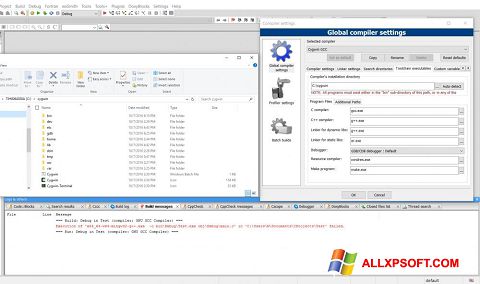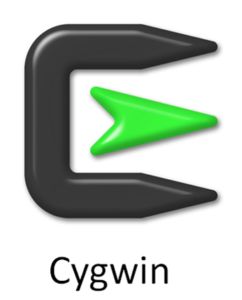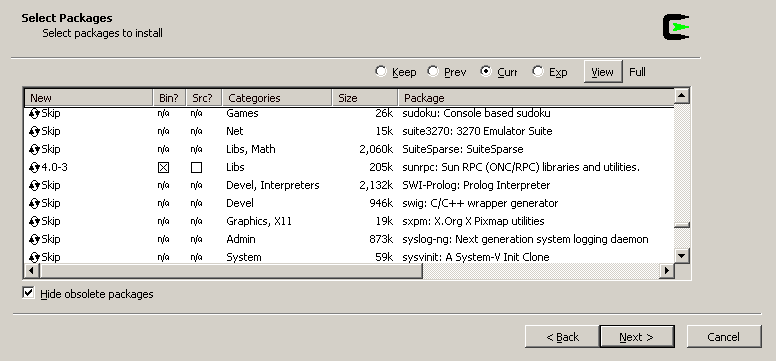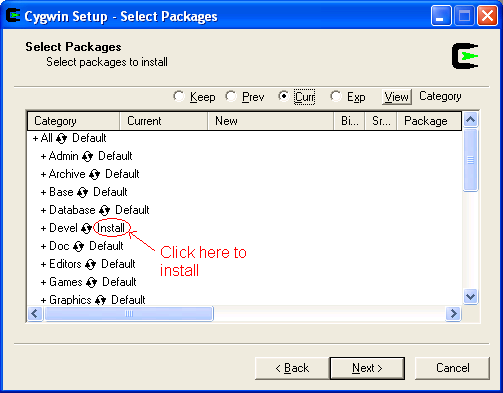- Cygwin Download
- How To Run Make From Cygwin Environment? - Stack Overflow
- You Have To Install The Make Command. Run The Cygwin Installation/configuration Program, Setup-x86_64.exe Or Setup-x86.exe (you Should Already Hav...
- Cygwin · GitHub
Install and maintain Cygwin¶ This guide was tested under Windows 10. It should be work with other supported Windows Versions too. Install Cygwin (without admin rights)¶ This documentation is based on Oliver Doepner's IT blog. Thank you for your work Oliver. Download setup-x8664.exe. Open command line window (WIN+R and type cmd). Cygwin related projects. Cygwin has 8 repositories available. Follow their code on GitHub.
Recently, Microsoft has made the first stable release of Windows Terminal, anew terminal program for Windows 10. Windows Terminal allows you to add and usemultiple shells, like Windows PowerShell, the old command prompt, and any shellin your Windows Subsystem for Linux (WSL) environments. It also provides waymore features and customization options than the old Windows console hostconhost.exe, which has been used for command prompt and WSL.
This post will instruct you to add other shell executables to Windows Terminal,such as the shell you installed for Cygwin or GitBash if you have Git for Windows. By doing this,you can access a Unix shell and potentially other Unix programs within WindowsTerminal without the need for WSL.
The main purpose of this post is to show you how to use your Cygwininstallation or Git Bash in Windows Terminal if you happen to have theminstalled. It is not intended to recommend Cygwin or Git Bash as WSLalternatives, though if you are interested, you may definitely try them.
The steps for Cygwin and Git Bash slightly differ, so I will first introducethe method for Cygwin, then mention what is different in the method for GitBash.
Steps for Cygwin
For the following steps, it is assumed that you have Bash installed in Cygwin.It should be possible to use other shells, but your configuration file willlook differently from what is shown here, so please pay attention to that.
Download Windows Terminal from MicrosoftStore.
Open Windows Terminal. You can find the button that opens the drop-down menuon the top, and the menu contains multiple profiles. We will create a newprofile for Cygwin’s shell.
In the drop-down menu, choose “Settings”. This will open up theconfiguration file for Windows Terminal. If you scroll down a little bit,you will see the
profileskey and thelistarray under it. This is wherethe new profile will be added to.The basic attributes for a profile are:
guid: A unique identifier for the profilename: The profile’s namecommandline: The command to start the shell used for this profile
The unique identifier in
guidcan be any 128-bit UUID that does not repeatany existing one in the configuration file. Please notice that you cannotreuse the identifier for a deleted preset profile. For instance, even ifyou never use the Azure Cloud Shell and deleted its profile, you should notuse that profile’sguidfor any new profile.After all, this should not be a problem because there are many ways to get aUUID:
- Run the
uuidgenprogram in Cygwin - Search for UUID generators online and use one of them
- Simply use the UUID I generated for the demo, which is
a1f2ceb2-795d-4f2a-81cc-723cceec49c0
- Run the
Now, you need to know the command line used to start Cygwin’s shell.
First, find your Cygwin installation path. By default, it is
C:cygwin64for the 64-bit version. Thebash.exeexecutable in a Cygwin installationshould be placed in thebinfolder under Cygwin’s installation path.Therefore, the absolute path to the executable file isC:cygwin64binbash.exeby default.For Bash in Cygwin, you need to start
bashas an interactive login shell;otherwise, you will encounter the “command not found” error when executingbasic commands likels. This is because the file/etc/profile, whichadds Cygwin’s/usr/binand/usr/local/bindirectories to thePATHenvironment variable, is not executed for non-login shells. An interactivelogin shell can be started with-i -lflags. If you are using anothershell, please confirm the way to get Cygwin’s/usr/binand/usr/local/binintoPATHfor your shell.Therefore, the full command to run Bash in Cygwin is
C:cygwin64binbash.exe -i -l. If you have installed Cygwin to anon-default path and/or want to use another shell, then please change thecommand accordingly.Finally, the configuration file accepts the forward slash
/as the pathcomponent separator, so you can replace every backslashin the commandwith/. For instance, the above command will be changed toC:/cygwin64/bin/bash.exe -i -l. If you want to use the backslash instead,you have to escape it by adding another backslash, causing the command tobecomeC:cygwin64binbash.exe -i -l.At this point you have collected all information needed for the new profile,so it’s time to add it to the configuration file:
The order of the profiles in the configuration is the same as the order inwhich they are shown in Windows Terminal. Here, because I want it to be thefirst entry, I put it before every other profile. If you are not adding itas the last profile, then don’t forget the trailing comma; otherwise, makesure the trailing comma is not there, and add a comma after the profile thatwas originally the last one.
Save the file. If your configuration file is valid, then you should now seethe new profile added to the menu. When you choose it, you should see Bashrunning in a new terminal tab.
Cygwin Download
Steps for Git Bash
The steps to add Git Bash differ at only two places:


How To Run Make From Cygwin Environment? - Stack Overflow

You cannot run
uuidgenin Git Bash to obtain a unique identifier. However,you can still use any alternative method mentioned above to get one.If you installed Git for Windows at
C:Program FilesGit, then the absolutepath to the Git Bash executable isC:Program FilesGitbinbash.exe.
Removing “Process Exited With Code x” Messages
If the last command you ran before quitting the shell using exit or Ctrl-Dfinished with a non-zero exit status, you might see something like what thescreenshot shows. Sometimes this can even happen if you did not run anycommand, which is likely to be caused by a command in initialization scriptslike .bashrc.
These messages must be dismissed manually. To stop Windows Terminal fromgenerating them, add an 'closeOnExit': 'always' option to the new profile inthe configuration file. Don’t forget, if this option is the last line for theprofile, you need to make sure a comma exists at the end of the previous line.
Setting Default Windows Terminal Profile
There is a defaultProfile option in the configuration file, which allows youto choose the default shell when a new terminal window or tab is opened. Thedefault profile should be specified by its guid.
Cygwin and MSYS2 -- as projects -- have significantly different goals.
Cygwin tries to bring a POSIX-compatible environment to Windows so that most software that runs on unices will build and run on Cygwin without any significant modifications. Cygwin provides a large collection of packages containing such software, and libraries for their development.

You Have To Install The Make Command. Run The Cygwin Installation/configuration Program, Setup-x86_64.exe Or Setup-x86.exe (you Should Already Hav...
MSYS2 tries to provide an environment for building native Windows software. MSYS2 provides a large collection of packages containing such software, and libraries for their development. As a large portion of the software uses GNU build tools which are tightly coupled to the unix world, this environment is also POSIX-compatible, and is in fact based on Cygwin.
Cygwin · GitHub
MSYS2 provides a minimal shell required to run autotools and other build systems which get the source for software from the Internet from different repositories, configure them and build them. The shell and core tools exist mainly to allow porting Unix programs to run natively on Windows (i.e. without requiring a POSIX emulation layer). MSYS2 doesn't try to duplicate Cygwin's efforts more than necessary, so the number of provided POSIX-emulated software is very small.
MSYS2 uses Pacman (known from Arch Linux) to manage its packages and comes with three different package repositories:
msys2: Containing MSYS2-dependent softwaremingw64: Containing 64-bit native Windows software (compiled with mingw-w64 x86_64 toolchain)mingw32: Containing 32-bit native Windows software (compiled with mingw-w64 i686 toolchain)
Cygwin comes only with Cygwin-dependent software. It uses its own package management system, commonly called setup.exe.
Cygwin provides a runtime library called cygwin1.dll that provides the POSIX compatibility layer where necessary. The MSYS2 variant of this library is called msys-2.0.dll and includes the following changes to support using native Windows programs:
- Automatic path mangling of command line arguments and environment variables to Windows form on the fly. (This can be selectively turned off.)
- Ability to change the reported OS using an environment variable (
MSYSTEM, with values ofMSYS2,MINGW32, andMINGW64). This allows mingw-w64 software to be built in native build mode (as opposed to cross-compilation mode). - Conversion of output of native Windown applications from Windows line endings to POSIX line endings by removing trailing
'r'characters, so that e.g.bb=$(gcc --print-search-dirs)works as expected. - Replacement of symlinks with copying, so that Windows programs don't trip up on these files. MSYS2 also supports creating native NTFS symlinks, but these are limited in other ways.
- Removal of the
/cygdriveprefix for automounts. This is to retain compatibility with MSYS-enabled software that makes assumptions about/c/being equivalent toC:/, and it saves a bit of typing. - Switch to
noaclon default mounts. This prevents any permission mangling from MSYS2. - MSYS2 releases might be ahead of or behind Cygwin releases.
Other notable differences:

- System root is
/usr, not/. - Removal of system integration stuff, such as
cyglsa,cygserver,cygstart... - Dynamic libraries are prefixed
msysinstead ofcyg(most other platforms, including mingw-w64, uselib). - Addition of the '-W' option to the
pwdcommand in shells for compatibility with the old MSYS. - Various changes in utilities to help retain compatibility and interoperability. An example is Perl reporting
msysas$^O, or Sed recognizing CRLF as a line ending.